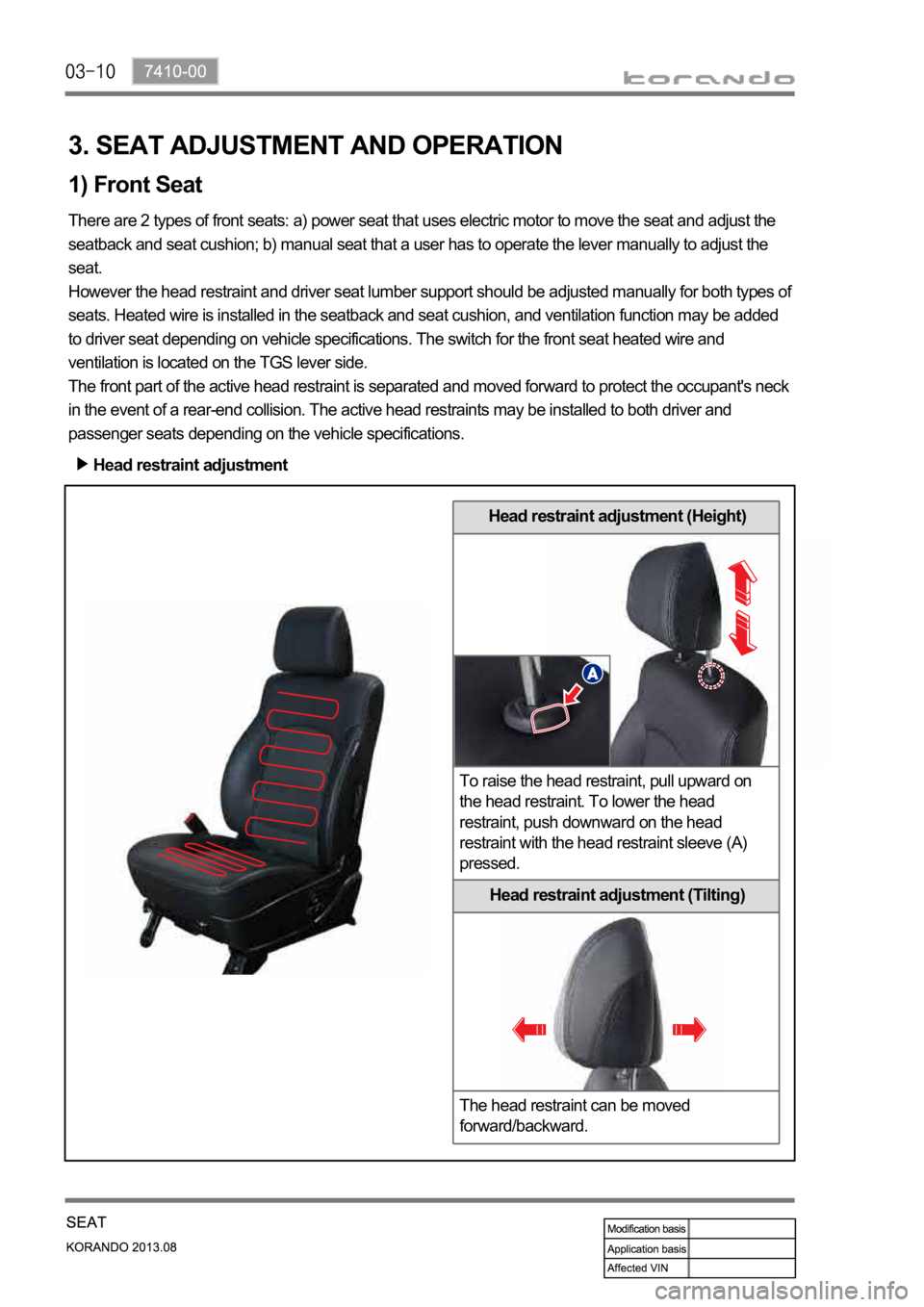Page 1263 of 1336

Head restraint adjustment (Height)
To raise the head restraint, pull upward on
the head restraint. To lower the head
restraint, push downward on the head
restraint with the head restraint sleeve (A)
pressed.
Head restraint adjustment (Tilting)
The head restraint can be moved
forward/backward.
3. SEAT ADJUSTMENT AND OPERATION
1) Front Seat
There are 2 types of front seats: a) power seat that uses electric motor to move the seat and adjust the
seatback and seat cushion; b) manual seat that a user has to operate the lever manually to adjust the
seat.
However the head restraint and driver seat lumber support should be adjusted manually for both types of
seats. Heated wire is installed in the seatback and seat cushion, and ventilation function may be added
to driver seat depending on vehicle specifications. The switch for the front seat heated wire and
ventilation is located on the TGS lever side.
The front part of the active head restraint is separated and moved forward to protect the occupant's neck
in the event of a rear-end collision. The active head restraints may be installed to both driver and
passenger seats depending on the vehicle specifications.
Head restraint adjustment
Page 1265 of 1336
Power seat Manual seat
Lowering the lumbar support lever moves the
lumbar support to the forward position, and raising
the lever moves the lumbar support to the
backward position.Lowering the lumbar support lever moves the
lumbar support to the forward position, and raising
the lever moves the lumbar support to the
backward position.
Power seat Manual seat
Moving the slide switch upward/downward moves
the seat cushion upward/downward as the front &
rear up/down motors rotate the rail.Pulling the recliner knob upward/downward moves
the seat upward/downward.
Seat adjustment (height)
Driver seat lumbar support adjustment
Page 1271 of 1336
Head restraint adjustment (Height)
3) Rear Seat
(1) Rear seat operation
The rear seat is a 6:4 split seat and a manual seat that the angle of the head restraint and seatback of the
seat can be adjusted. And the heated wires in the rear seat cushion and seatback can be operated with
rear seat heated wire switches located on the LH/RH rear door trim.
The head restraint can be raised
without pressing the head
restraint sleeve (A) or lowered
with the sleeve (A) pressed.
Seatback reclining adjustment
To adjust the seatback angle,
pull the lock release lever on the
upper part of the seat to release
the lock.
Page 1278 of 1336
7410-00
The 3-point type seat belts are mounted on the driver seat, passenger seat and rear seats (LH, RH,
Center). The seat belts on the front seats (driver's/passenger's) include pretensioner feature which
rewinds the seat belt immediately to protect the occupant's face and chest when a strong frontal collision
occurs.
Front 3-point type seat belt
(Driver & Passenger seats)
Rear 3-point type seat belt (RH)
Front seat belt
Height adjuster
Rear seat belt - RH Rear seat belt - LH
Rear double buckle -
1st row
Rear center seat belt
Rear buckle - 1st row
6) Seat Heated Wire and Ventilation
(1) Seat belt configuration
3-point type seat belt
(RR center, LH)
Page 1280 of 1336
7410-00
Pretensioner
Driver sidePassenger side
7) Mounting Location for Pretensioner
The seat belt pretensioner retracts the seat belt instantly by igniting the inflator in the pretensioner when
the front air bag system is activated. It also improves the safety effect of the seat belt by preventing the
front seat occupants from moving forward and keeping occupants in a stable posture.
The load limiter is also installed to reduce the chest impact to a front seat occupant by loosening the seat
belt while maintaining the force applied by the seat belt uniformly when the pretensioner retracts the seat
belt instantly. The seat belt pretensioner is operated first, and then the load limiter is activated.
Height adjuster
This feature improves
comfort and enhances
safety performance in the
event of a collision by
adjusting the shoulder belt
to the desired length to
restrain the occupant.